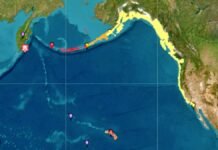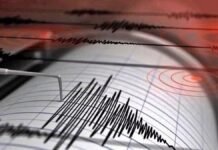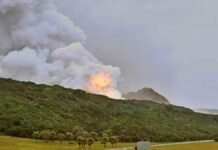
Key Points:
- Earthquake in Japan: A 6.0 magnitude earthquake struck Kyushu on April 2, with no immediate reports of major damage or casualties.
- Megaquake Warning: The Japanese government has warned of an 80% chance of a catastrophic 9.0 magnitude earthquake along the Nankai Trough.
- Myanmar Devastation: Just days earlier, a 7.7 magnitude earthquake in Myanmar caused over 3,800 deaths and widespread destruction.
Tokyo: On the evening of April 2, a powerful 6.0 magnitude earthquake shook Japan’s Kyushu region, as confirmed by the Japan Meteorological Agency (JMA). The tremor, which occurred at a depth of 40 kilometers, caused buildings to sway but resulted in no immediate reports of significant damage or casualties. This comes just days after Myanmar experienced a devastating 7.7 magnitude earthquake, raising regional concerns about seismic preparedness.
Details of the Earthquake
The earthquake struck at approximately 7:34 PM local time and was felt across multiple areas in Kyushu. While the tremor caused moderate shaking, officials have classified the risk of fatalities and economic losses as low. However, the event has reignited fears about Japan’s vulnerability to larger seismic events.
Megaquake Warning Looms
The Japanese government recently issued a sobering report warning of an impending “megaquake” along the Nankai Trough, an undersea fault stretching from Shizuoka to Kyushu. Experts estimate an 80% probability of a magnitude 8 to 9 earthquake occurring in this region within the next three decades.
In the worst-case scenario:
- Up to 298,000 fatalities could result from tsunamis and building collapses.
- Around 1.23 million people may need to evacuate.
- Economic losses could reach $1.8 trillion, nearly half of Japan’s GDP.
The Nankai Trough is one of the most seismically active zones in the world, where tectonic stress builds as the Philippine Sea Plate subducts beneath the Eurasian Plate. Historically, megaquakes in this region occur every 100–200 years, with the last major event recorded in 1946.
Myanmar Earthquake Adds to Regional Concerns
Meanwhile, Myanmar continues to grapple with the aftermath of its most powerful earthquake in over a century. The 7.7 magnitude quake on March 28 devastated regions near Mandalay and Sagaing:
- Over 3,800 fatalities reported.
- More than 4,700 injuries and hundreds missing.
- Extensive damage to homes, bridges, and religious sites.
Relief efforts have been hindered by ongoing civil conflict and damaged infrastructure, leaving thousands without access to basic necessities like food and water.
Japan’s Preparedness Measures
In light of these seismic events, Japanese authorities are urging citizens to:
- Stockpile emergency supplies such as food, water, and first aid kits.
- Develop evacuation plans with family members.
- Stay informed through official channels for real-time updates.
Japan has also invested heavily in disaster-resilient infrastructure and early warning systems since the catastrophic 2011 Tohoku earthquake and tsunami that claimed over 15,000 lives.
As seismic activity intensifies across Asia, Japan’s recent tremor serves as a stark reminder of the region’s vulnerability to natural disasters. While no significant damage has been reported from Kyushu’s earthquake, the looming threat of a megaquake underscores the need for vigilance and robust disaster preparedness strategies.





















































